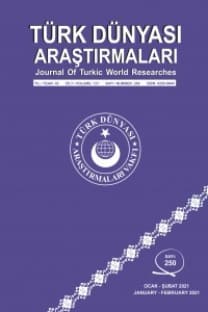İç Asya ve İmparatorluğun Mekânsal Politikaları: Arkeoloji, Hareketlilik ve Kültür İletişimi
Bu kitap incelemesi, batılılar tarafından geliştirilen göçebeler devlet kuramaz tezlerine karşı çıkan ve arkeolojik dayanaklarla karşı tezini ileri süren William Honeychurch ve eserini Türk araştırmacıların bilgisine sunmak amacıyla yapılmıştır.
Anahtar Kelimeler:
William Honeychurch, Göçebe Devlet, İlk Türk Devletleri
___
- Barfield, Thomas. (2011). Nomadic pastoralism in Mongolia and beyond. Mapping Mongolia: Situating Mongolia in the world from geologic time to the present (edt. P. Sabloff). Philadelphia: University of Pennsylvania Press. s. 104–124.
- Di Cosmo, Nicola. (2011). Ethnogenesis, coevolution and political morphology of the earliest steppe empire: The Xiongnu question revisited. Xiongnu archaeology: Multidisciplinary perspectives of the first steppe empire in Inner Asia (edt. U. Brosseder & B. Miller). Bonn: Rheinische Friedrich-Wilhelms-Universität. s. 35–48.
- Honeychurch, william. (2015). ınner asia and the spatial politics of empire: archaeology, mobility, and culture contact. new york, heidelberg, dordrecht, london: springer.
- Ingold, T. (2000). Perception of the environment: Essays on livelihood, dwelling and skill. London: Routledge
- Khazanov, Anatoly. (1994). Nomads and the outside world. Madison: University of Wisconsin Press.
- Kradin, Nikolay (2011). Stateless empire: The structure of the Xiongnu nomadic super-complex chiefdom. Xiongnu archaeology: Multidisciplinary perspectives of the first steppe empire in Inner Asia (edt. U. Brosseder & B. Miller). Bonn: Rheinische Friedrich-Wilhelms-Universität. s. 77–96.
- Kürsat-Ahlers, Elçin. (1996). Aspects of state formation processes among the ancient Eurasian nomads. The evolution of nomadic herding civilizations in the Northern European Steppes: The tools of archaeology and history compared (edt. G. Afanase’ev, S. Cleuziou, J. Lukacs & M. Tosi). Colloquia of the XIII International Congress of Prehistoric and Protohistoric Sciences Abaco, Forlì, Italy, s. 25–48.
- Salzman, Peter C. (2004). Pastoralists: Equality, hierarchy, and the state. Boulder, CO: Westview Press
- ISSN: 0255-0644
- Başlangıç: 1979
- Yayıncı: Türk Dünyası Araştırmaları Vakfı
Sayıdaki Diğer Makaleler
Bir Jurnal Hikayesi: Ebubekir Hazım Bey'in Dedeağaç Mutasarrıflığı ve Azli
Mehmet Akif Ersoy ve Aşık Şenlik’te Medeniyet Kimliği: Kendilik Bilincinin Fenomenolojik Dışa Vurumu
İç Asya ve İmparatorluğun Mekânsal Politikaları: Arkeoloji, Hareketlilik ve Kültür İletişimi
Ay Yıldızın İzinde Kıbrıs ve Irak Türkleri
PKK Terör Örgütünün Değişimi ve Dönüşümünün Bölgesel Güvenliğe Etkileri: Suriye Örneği
